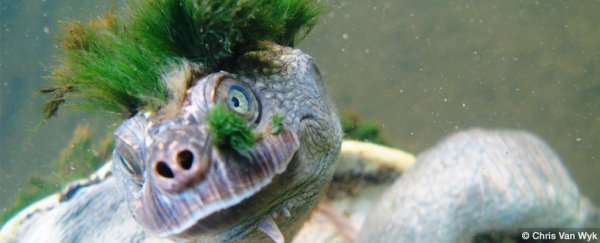It's a punk rocker! It's a troll doll! Oh no, wait - it's just another remarkable species on the brink of extinction.
The Mary River turtle (Elusor macrurus) is like no creature you've ever seen before, and there's definitely a reason for that.
The 40cm-long water turtle - complete with wide nostrils, chin fingers and sometimes a nice algae hairdo - can only be found on the Mary River in Queensland, Australia.
It's also one of the most endangered species on the planet. That's why the Zoological Society of London (ZSL) has now ranked the Mary River turtle 29th on a new list of the most vulnerable reptile species.
"Reptiles often receive the short end of the stick in conservation terms, compared with the likes of birds and mammals," said Rikki Gumbs, co-ordinator of ZSL's Evolutionarily Distinct and Globally Endangered (Edge) list for reptiles.
"The Edge reptiles list highlights just how unique, vulnerable and amazing these creatures really are."
Unfortunately, the Mary River turtle's unique looks are exactly what has doomed the species. During the 1960s and 70s, the docile turtle was an extremely popular pet - because of course it was.
Every year for ten years, over 15,000 hatchlings were sent to pet shops across Australia, and, after years of pillaging nest sites, humans successfully drove the species to the brink of extinction.
Now, conservationists are struggling to keep the unique species alive.
"Just as with tigers, rhinos and elephants, it is vital we do our utmost to save these unique and too often overlooked animals," said Gumbs.
"Many Edge reptiles are the sole survivors of ancient lineages, whose branches of the tree of life stretch back to the age of the dinosaurs."
When it comes to the Mary River turtle, this is especially true. No other turtle in the world is even closely related to it, because it diverged from modern turtles around 40 million years ago.
To put that into perspective, modern humans only diverged from chimpanzees and bonobos less than 10 million years ago.
As a result, the Mary River turtle has a ton of unique features, which no other modern turtle has.
For instance, it has a super long tail, which can grow up to 70 percent longer than the length of its shell, and it also has two rows of tubercles under its chin, which allow the turtle to feel around on the soft river bed.
Plus, did we mention it can breathe through its butt? That's right - the Mary River turtle has gill-like structures near its rear-end that allow it to breathe oxygen under water for up to three days.
But while the bizarre appearance of the Mary River turtle was ultimately its downfall, its peculiar look could also be its saving grace.
In 2009, when the construction of a dam threatened the already endangered creature's habitat, a series of viral photos of a turtle with crazy green algae "hair" turned the species into a local mascot for conservationists. After public outcry over the environmental impact, plans for the dam were ultimately scrapped.
But the struggle is far from over. The Mary River turtle continues to be threatened by feral animals, cattle grazing, and water quality, which has declined significantly in the past 20 years.
Research biologists now estimate that the turtle's total population has been depleted by more than 95 percent from historic levels.
"If we lose these species there will be nothing like them left on Earth," said Gumbs.
If we lose this species, it will definitely be our fault.
